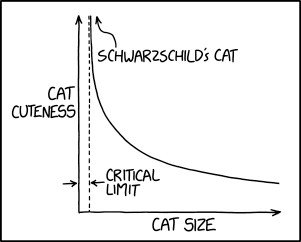Schwarzschild's Cat

Cats can be smaller than the critical limit, but they're unobservable. If one shrinks enough that it crosses the limit, it just appears to get cuter and cuter as it slowly fades from view.

Cats can be smaller than the critical limit, but they're unobservable. If one shrinks enough that it crosses the limit, it just appears to get cuter and cuter as it slowly fades from view.
This comic is primarily a wordplay joke about the Schwarzschild radius, or the distance from a black hole corresponding to the event horizon.The Schwarzschild radius for a given body is the limit to which a given mass can be shrunk down before it becomes a black hole - the Schwarzschild radius also represents the event horizon of this newly-created black hole. The event horizon, in turn, is the limit from which nothing can leave a black hole; not even light. The joke is that, apparently, smaller cats are cuter, and there is a limit below which a sufficiently small cat (but larger than zero) will approach infinite cuteness, in a similar pattern to the way time's rate for an observer will approach infinity, the closer they get to the event horizon of a black hole.
It's also an oblique reference to the Schrödinger's cat thought-experiment, since the names (Erwin) "Schrödinger" and (Karl) "Schwarzschild" are somewhat similar and both men were early 20th-century physicists who exchanged ideas with Albert Einstein. However, the actual comic doesn't bring up quantum superposition.
The title text makes two allusions. First, it alludes to what happens when an object falls into a black hole. From an outside observer's point of view, such objects appear to slow down and take an infinite amount of time to cross the event horizon due to the time dilation of General relativity. The object's photons become increasingly red-shifted, fading as they lose energy to the black hole's gravity well. The scientific consensus suggests that from the falling object's point of view, it should continue to experience time and cross the Schwarzschild radius, but that event is unobservable from the outside (hence the term "event horizon").
Second, the title text is a play on the Cheshire Cat from Alice in Wonderland, which slowly fades from view until only its grin remains.
Randall previously discussed the superiority of tiny mammals in 1682: Bun, and drew graphs relating to the perceived cuteness of cats in 231: Cat Proximity.